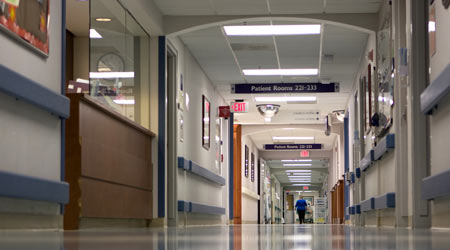
The Christ Hospital Health Network is the first healthcare system in the region to use five Xenex LightStrike Germ-Zapping Robots to enhance environmental cleanliness and transform the way care is delivered by disinfecting and destroying hard-to-kill pathogens in hard-to-clean places.
These five Xenex robots, named after The Christ Hospital team members, use Full Spectrum™ pulsed xenon ultraviolet (UV) light to quickly destroy bacteria, viruses, fungi and bacterial spores. The portable disinfection system is an emerging technology in healthcare focusing on the most effective and efficient method of sanitizing surfaces throughout hospitals and healthcare facilities. These technologies enable environmental services personnel to increase their effectiveness in providing the safest environment for patients and staff.
“We want to do everything within our means to provide the safest and cleanest environment at all of our facilities. This is one more tool to help reduce the risk of hospital acquired infections,” said Deborah Hayes, Vice President and Chief Operating Officer of The Christ Hospital. “The Christ Hospital has long been recognized as a leader in medical technology and highly specialized care in our clinical areas, so it’s only fitting that we should employ innovative technological solutions to care for our facilities. One hospital acquired infection is one too many, so we are excited to begin using the Xenex system to ensure that we have a comprehensive tool belt to assist us in delivering the finest quality of care. Our mission is to continue innovating to improve the health of the community by creating patient value and this is one more way in which we can demonstrate that.”
UV light has been used for disinfection for decades. The Xenex LightStrike Germ-Zapping Robot is a new technology that utilizes pulsed xenon (not mercury bulbs) to create germicidal UV light. Pulsed xenon emits high intensity UVC light which penetrates the cell walls of microorganisms, including bacteria, viruses, mold, fungus and spores. Their DNA is fused, rendering them unable to reproduce or mutate, effectively killing them on surfaces without contact or chemicals. The Xenex system is effective against the most dangerous pathogens, including Clostridium difficile (C. diff), Methicillin-resistant Staphylococcus aureus (MRSA), VRE, Ebola, norovirus and influenza.
The portable Xenex system can disinfect a typical patient or procedure room in four or five minute cycles (depending on the robot model) without warm-up or cool-down times. It can be used in any department and in any unit within a healthcare facility, including isolation rooms, operating rooms, general patient care rooms, contact precaution areas, emergency rooms, bathrooms and public spaces.
The Xenex pulsed xenon UV disinfection system has been credited by health care facilities across the U.S. for helping them reduce their infection rates significantly. Several hospitals have published their C.diff, MRSA and Surgical Site infection rate reduction studies in peer-reviewed journals - showing infection rate reductions in excess of 70 percent. Nearly 400 hospitals, Veterans Affairs and DoD facilities in the U.S., Canada, Africa, UK and Europe are using Xenex robots, which are also in use in skilled nursing facilities, ambulatory surgery centers and long term acute care facilities.

 The Down and Dirty on Cleaning in Virus Season
The Down and Dirty on Cleaning in Virus Season How Surfactant Use is Expanding in Commercial Cleaning
How Surfactant Use is Expanding in Commercial Cleaning Clean Buildings Conference
Clean Buildings Conference